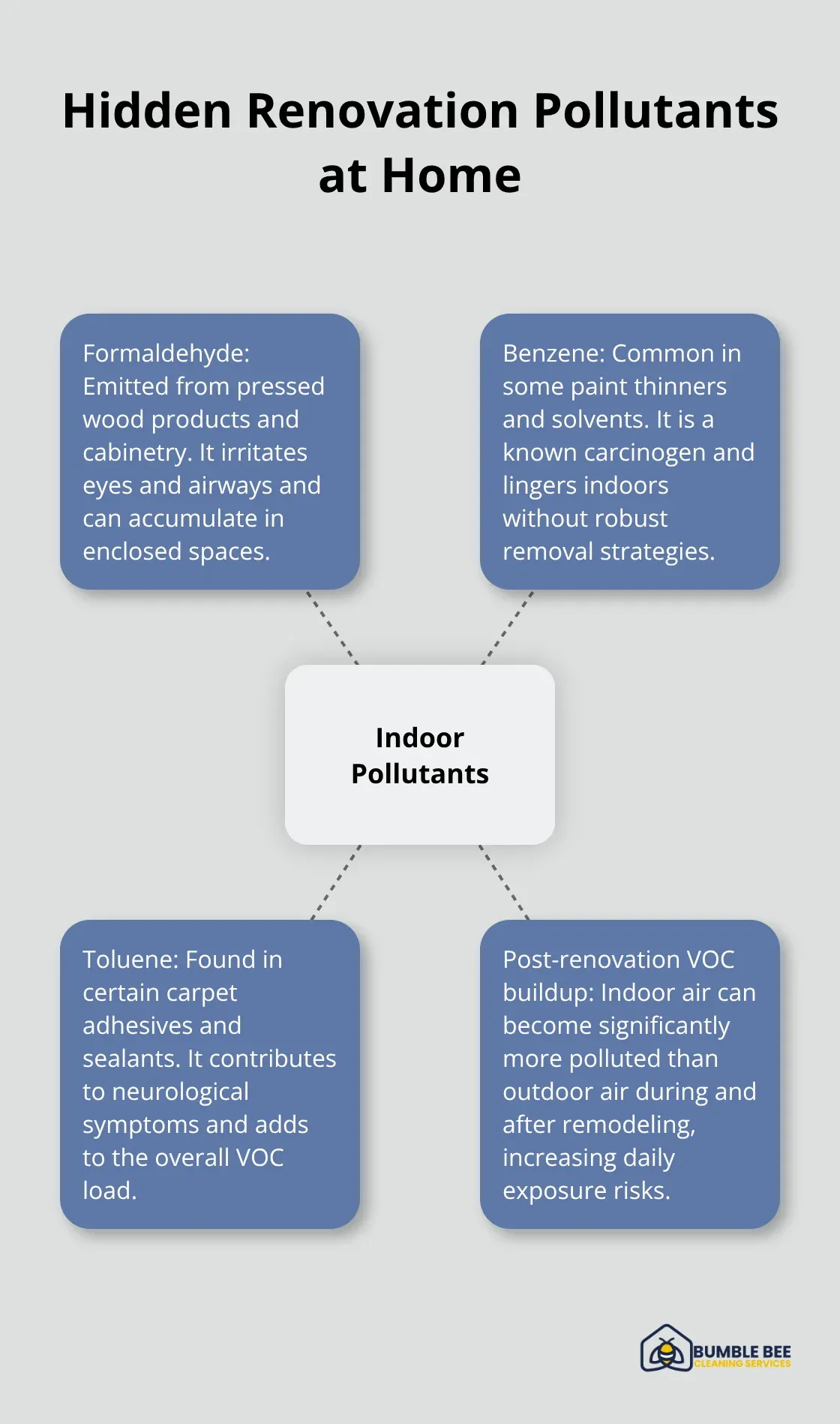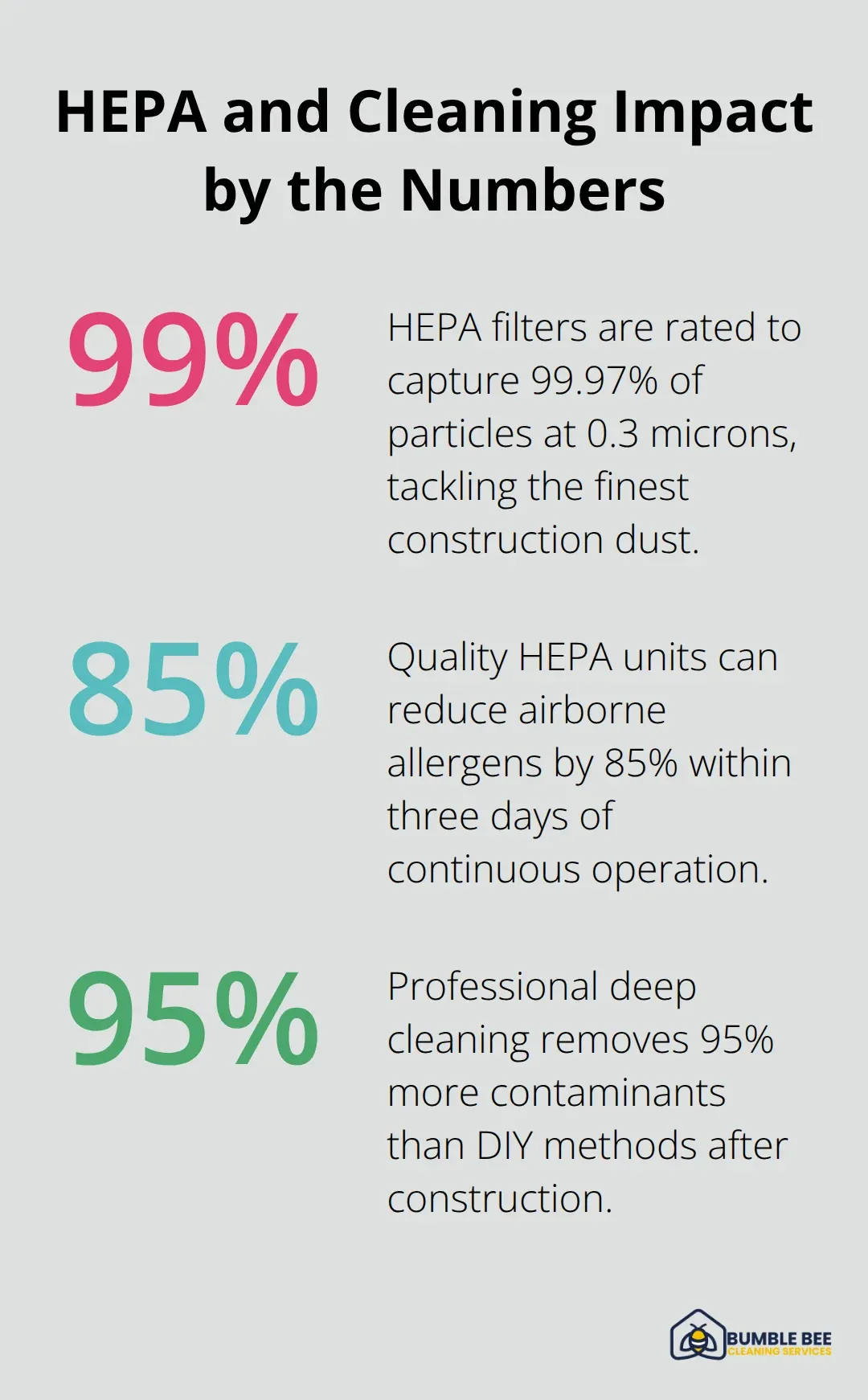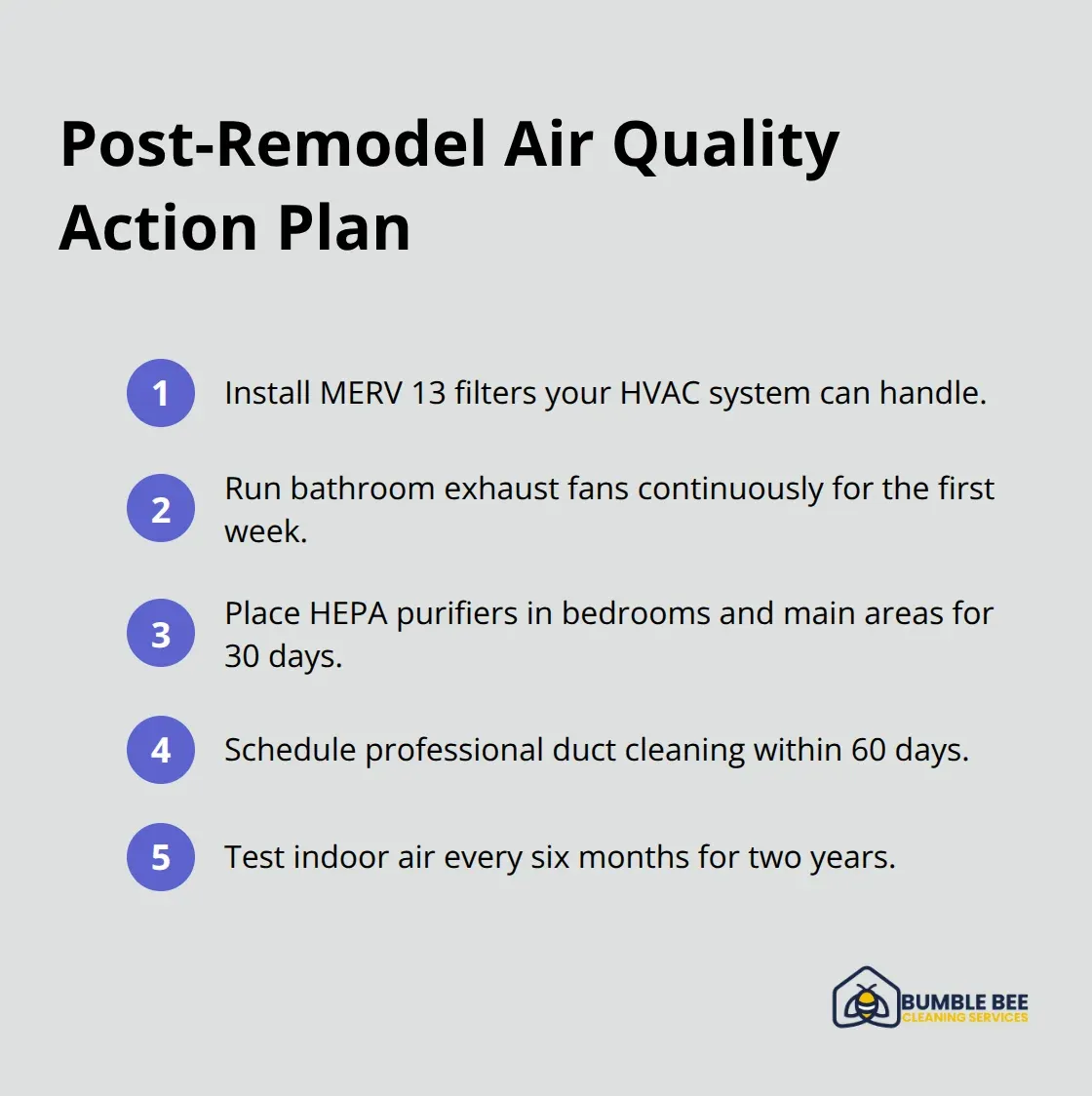Your Seattle home renovation looks amazing, but post-renovation air quality issues can linger for months. Construction dust, paint fumes, and adhesive chemicals create invisible health risks that standard cleaning can’t address.
We at Bumble Bee Cleaning Services see homeowners struggle with respiratory irritation and headaches weeks after contractors finish. The good news? Simple air quality hacks can transform your newly remodeled space into a healthy haven.
What Air Pollutants Hide in Your Remodeled Home
Construction Materials Release Dangerous Chemicals
Your beautiful new kitchen cabinets and fresh paint job carry an invisible price. Building materials are significant sources of volatile organic compounds that determine long-term indoor air quality levels. The Environmental Protection Agency found that indoor air becomes 2 to 5 times more polluted than outdoor air, especially during and after renovations.
Formaldehyde from pressed wood products, benzene from paint thinners, and toluene from carpet adhesives create a toxic mixture that standard ventilation cannot eliminate. These chemicals build up in closed spaces and reach dangerous concentrations that affect your family’s health daily.

Health Problems Start Within Days
Headaches, eye irritation, and respiratory issues represent more than temporary inconveniences after remodeling. The World Health Organization links extended exposure to poor indoor air quality with serious respiratory ailments and cardiovascular diseases. Children face the highest risk because their developing lungs absorb pollutants faster than adults.
Families experience persistent coughing, allergic reactions, and sleep disruption weeks after contractors leave. The American Lung Association reports that these symptoms often worsen at night when ventilation decreases and pollutant concentrations spike.
Professional Testing Reveals Hidden Dangers
Home air quality monitors miss many construction-related pollutants that require laboratory analysis. Professional testing offers indoor air quality monitoring for contaminants such as mold, VOCs, metals, and dust. Testing costs between $400-800 but prevents thousands in medical bills and reveals problems before they become health emergencies.
Post-construction testing should happen 72 hours after work completion and again after 30 days to track pollutant decay rates. Once you understand what contaminants lurk in your air, you can take immediate action to protect your family’s health.
How Do You Clear Toxic Air Fast After Remodeling
Smart Ventilation Beats Seattle’s Weather Challenges
You need to open windows for 30 minutes daily to reduce indoor air pollutants dramatically according to the Centers for Disease Control and Prevention, but Seattle’s rainy climate demands smarter ventilation strategies. Cross-ventilation works best when you open windows on opposite sides of your home to create airflow that pushes contaminated air out while it pulls fresh air in. For bathrooms, ASHRAE 62.99 recommends that you exhaust 25 cubic feet per minute with a continuously operating fan, or 50 cfm for intermittent operation, which means you should run exhaust fans continuously for the first week after construction. Box fans positioned in windows can triple natural ventilation rates when outdoor air quality permits (especially during Seattle’s clearer days).
HEPA Filters Capture What Standard Units Miss
Standard air purifiers fail against microscopic construction dust that floats for weeks after you complete your remodel. HEPA filters can theoretically remove at least 99.97% of dust, pollen, mold, bacteria, and any airborne particles with a size of 0.3 microns, which includes the fine dust that causes respiratory irritation. You should place HEPA air purifiers in bedrooms and main areas, then run them 24 hours daily for the first month after construction. The American Lung Association confirms that quality HEPA units reduce airborne allergens by 85% within three days of continuous operation.

Professional Deep Cleaners Target Hidden Toxins
Regular cleaners miss toxic residues that embed in surfaces and hidden corners where construction dust settles. Post-construction cleanup requires specialized equipment and techniques that target microscopic particles standard methods cannot reach. Professional services use HEPA-filtered vacuums and specific solutions designed to neutralize construction chemicals rather than just move dust around (which standard cleaning often does). Professional deep cleaning removes 95% more contaminants than DIY methods and prevents long-term health issues that develop when toxic particles remain embedded in your home.
These immediate steps provide quick relief, but you need ongoing strategies to maintain the air quality improvements you’ve achieved.
How Do You Keep Clean Air Long Term
HVAC Systems Need Monthly Attention
Your heating and cooling system becomes the most important air quality tool after remodeling work ends. The EPA recommends using filters rated MERV 13 or better during post-construction periods, or as efficient a filter as your system can accommodate. High-efficiency filters with MERV ratings between 8-13 capture construction dust that standard filters miss, but avoid MERV 16 filters because they restrict airflow and damage your system. Professional duct cleaning within 60 days of construction completion removes embedded particles that circulate through your home for years. Seattle’s moisture levels require additional attention to condensation drains and coils where mold develops quickly after construction dust settles.
Testing Every Six Months Prevents Health Problems
Post-construction air quality changes dramatically over time, which makes regular monitoring essential for family health protection. Professional testing should occur at six-month intervals for the first two years after major remodeling because VOC levels fluctuate with temperature and humidity changes. Home air quality monitors track particle counts and humidity levels daily, but they cannot detect specific chemicals that require laboratory analysis. Regular testing helps homeowners identify air quality issues and take corrective action before problems escalate.
Smart Material Choices Stop Future Problems
Future renovation projects offer opportunities to prevent air quality issues before they start. Low-VOC paints reduce chemical emissions by 85% compared to standard formulations, while zero-VOC options eliminate petroleum-based solvents entirely. Natural materials like solid wood, bamboo, and stone release minimal chemicals compared to engineered products with adhesives and synthetic components. Professional contractors who prioritize air quality use dust containment systems and negative air pressure during work (which prevents contamination from spreading throughout your home). These preventive measures cost 20% more upfront but eliminate expensive remediation and health problems that develop from poor material choices.
Professional Maintenance Services Protect Your Investment
Regular professional maintenance keeps your air quality improvements intact over time. HVAC technicians should inspect your system twice yearly to check for dust buildup and filter efficiency (especially important in Seattle’s humid climate). Professional cleaning services that specialize in post-construction work understand which surfaces harbor invisible contaminants and use appropriate equipment to address them. These services cost less than medical bills from respiratory problems that develop when air quality deteriorates over time.
Final Thoughts
Post-renovation air quality problems demand immediate action and constant attention to protect your family’s health. You must open windows daily for 30 minutes, run HEPA air purifiers continuously for the first month, and schedule professional testing within 72 hours after construction ends. These actions reduce harmful pollutants by up to 85% and prevent respiratory issues that develop when toxic particles stay in your home.
Professional cleaners become necessary when you experience persistent headaches, respiratory irritation, or chemical odors weeks after contractors finish. Standard methods cannot remove microscopic construction dust and chemical residues that embed in surfaces throughout your home. We at Bumble Bee Cleaning Services use HEPA-filtered equipment and techniques that neutralize construction chemicals rather than simply move dust around.

You should install MERV 13 filters in your HVAC system, schedule professional duct work within 60 days, and establish six-month air quality tests (which track pollutant changes over time). These preventive measures cost significantly less than medical bills from respiratory problems that develop when post-renovation air quality deteriorates. Take action now to protect your family from invisible health risks that linger long after your beautiful remodel appears complete.
